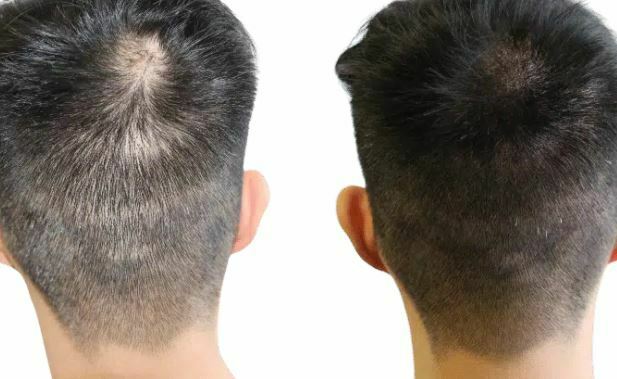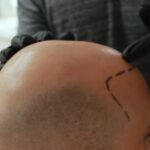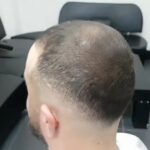Do you or someone you know suffer from low hair density? Have you been struggling with areas that have a lot of contrast between actual hair and scalp due to thinning? Have you been wanting to add density to your existing hairline? Did you know that Scalp Micropigmentation can help you add hair density? This is exactly what we’ll be sharing with you, hair density simulation.
Your hair density is the number of strands of hair growing out of each square inch of your scalp.
Hair density is different for everybody, some are just born with high density while others, not so much. However, nowadays there are different ways in which you can improve your hair density, one being surgery.
If you can relate, you may be interested in learning what you can do to improve your hair density. If you have a low hair density, you may want to stick to hair products and hairstyles that add volume. You could also try procedures such as scalp micropigmentation which seems to be the latest trend to create hair density simulation.
Hair Density Simulation FAQ’s
What is hair density?
You can categorize your hair in many ways; by its length, color, texture, coarseness, or density. Your hair density refers to how many strands of hair grow per square inch of your scalp.
In simple terms, hair density denotes the number of strands on your scalp. Generally, it is calculated as the number of hair strands per sq inch on your scalp. On average, a person has around 2200 hair strands per square inch on their scalps.
Hair density goes beyond the thickness of the strand. If you have more hair strands on your scalp, your hair will appear thicker. When there is a loss of hair patches, it can lead to your hair looking thin and dead. On that account, it is important to reduce hair fall to increase hair density.
Why should you improve hair density?
Hair density is one factor that determines how to best style your hair. Hair density is classified as thick, medium, and thin. People prefer having thick hair as they get the liberty of styling them in several ways. On the other hand, people with thin hair have to resort to volumizing products to add luster and thickness. This process can be cumbersome as well as expensive.
How to determine hair density?
- If you want to accurately determine your hair density you would need to count the individual strands in a 1-inch by 1-inch section of your scalp.
The gold standard method of measuring hair density is with a phototrichogram, an imaging technique that allows researchers to measure hair density and the growth phase of each individual hair. - At home you could do a visual inspection; if you can see your scalp without moving your hair, your hair density is likely on the lower end. If you need to move your hair slightly to see your scalp, your density is probably somewhere in the middle. If it’s difficult to see your scalp, your hair density is likely high.
How you should care for your hair depending on hair density?
Low-density
If you have low hair density, you may want to avoid heavy products that weigh your hair down like heavy oils and conditioners.
Look for products that can add volume to your hair like volumizing shampoos, dry shampoo, and mousse.
Medium-density
If your hair density falls somewhere in the middle, you don’t need to do much to change the volume of your hair. You can focus on products that help keep your hair healthy.
High-density
If you have a higher hair density, you may need heavier styling products like gels and butter to get your hair to stick and keep it under control. Hairstyles that remove excess bulk may work best for you.
What causes low hair density?
- Genetics: If you are born with low hair density, it will be difficult for you to change that. A hair follicle is the part of the skin on your head through which the hair grows out.
- Dietary issues: Eating lots of junk food will pull you away from your dream of having long and thick hair. If your diet is not filled with vitamin B3 and C, you will notice a significant and negative change in your hair density.
- Stress: Stress and hair fall are related on a deeper level. According to studies, three types of hair losses are related to lower hair density.
- Lack of hair care: Your hair will only be your companion as long as you take care of it. Hair density could get lower in the absence of proper maintenance. You must brush your hair regularly to promote healthy blood circulation.
Is it possible to improve hair density?
Hair transplantation surgeries may help cover patchy areas of hair growth, but if you were born with low hair density, there’s currently no way to change that.
Even though hair density depends on several biological factors and genetics, you can alter your diet and lifestyle to increase hair growth. Moreover, brushing your hair regularly while using a good shampoo can go a long way in improving hair density.
How can I increase hair density?
- Use the right shampoo and conditioner: The next time you buy shampoo, look beyond the brand and focus on the components. If you want an effective anti-hair fall shampoo, go for the one that will have collagen, rice protein, keratin, zinc, biotin, etc. Such components will strengthen your hair while also nourishing them.
- Wash your hair gently: People assume that they must wash their hair rigorously while scrubbing their scalp. But you must gently clean your scalp with your fingers. Do not try to scrub it with your nails, as it can cause infections or abrasions. Avoid shampooing their hair tips as they will be cleaned and taken care of by the conditioner.
- Massage your scalp: A regular oil massage can help you control your hair fall and improve hair density. It promotes blood circulation and strengthens the roots.
- Change your diet: A healthy diet can bring several benefits to the table. A simple change in your diet can improve the growth, texture, and density of your hair. Fill your diet with food containing vitamin B3, B6, acid, zinc, antioxidants, folic acid, etc.
- Use aloe vera gel: Aloe vera gel is known to improve hair quality as well as minimize damage. It helps in soothing and conditioning the scalp. Moreover, it unblocks the hair follicles and helps in enhancing healthy hair growth.
- Fenugreek seeds: Besides Vitamin C and protein, it contains iron that helps with blood circulation. This can help in fighting grey hair. Lastly, nicotinic acid boosts hair density while enhancing hair volume.
Is it possible to simulate hair density?
Follicular unit transplant (FUT) and follicular unit extraction (FUE) surgery are two methods of hair transplantation.
Typically, follicles are taken from one part of your scalp and transplanted to areas of your scalp that are balding or have poor hair density.
During FUT surgery, a surgeon cuts a strip of skin, typically from the back of the scalp, and then removes individual follicles. During FUE, the surgeon removes individual follicles directly from the scalp.
Is it possible to simulate hair density without surgery?
Scalp Micropigmentation is an excellent solution for those who want to add the appearance of a full head of hair to areas that have a lot of contrast between actual hair and scalp due to thinning. Men and women alike can choose to receive Scalp Micropigmentation to add density to their existing hairline without having to shave their heads.
Is it necessary to shave the entire head to add density with scalp micropigmentation?
Although a fully shaven head is most common for Scalp Micropigmentation, many clients receive treatment to add density to thinning hair or bald spots, in which case shaving is not necessary. For this kind of treatment to have a natural appearance, it is actually necessary to have hair distributed all over the head.
What are the best hair types for adding density?
- When it comes to the type of hair loss, Diffuse Thinning and Female Pattern Hair Loss are both the ideal types of hair loss for Scalp Micropigmentation, because thinning hair with an intact hairline is the best-case scenario for Scalp Micropigmentation treatments on longer hair.
- With diffuse thinning and general female pattern hair loss, hair is typically more or less thinned out rather than balding in one concentrated area. This allows specialists to fill in these areas where there may be thinning hair and the scalp is showing through.
- Larger balding spots are not ideal to receive Scalp Micropigmentation for density because the areas that receive the Scalp Micropigmentation treatment will be too noticeable if there are long strands of hair surrounding the bald spots.
Hair Density Simulation
- Scalp Micropigmentation (SMP) is a great way to add the natural look of density to existing hair. With the careful and precise application, men and women alike can receive treatment with remarkably natural results.
- The treatment aims to compliment the person’s existing hair and hairline. For this to be possible, the client must have some diffuse thinning with an intact hairline.
- Because Scalp Micropigmentation treatments do not add any physical length to existing hair, there must be an all-over distribution of existing hair in order to achieve a completely natural look.

Procedure:
- The Scalp Micropigmentation treatment typically takes 2-4 hours per session depending on your degree of hair loss.
- Most people can expect between 2-4 sessions to complete their treatment depending on the extent of hair loss or scarring. These treatments are usually spaced about 10-20 days apart.
- Scalp Micropigmentation is a non-invasive treatment that uses detailed micro-needles to deposit pigment into the scalp.
- The result creates the appearance of tiny hair follicles or short hair stubble. If you are starting to thin, recede, or if you are completely bald, it can give you the look of a short buzz cut.



